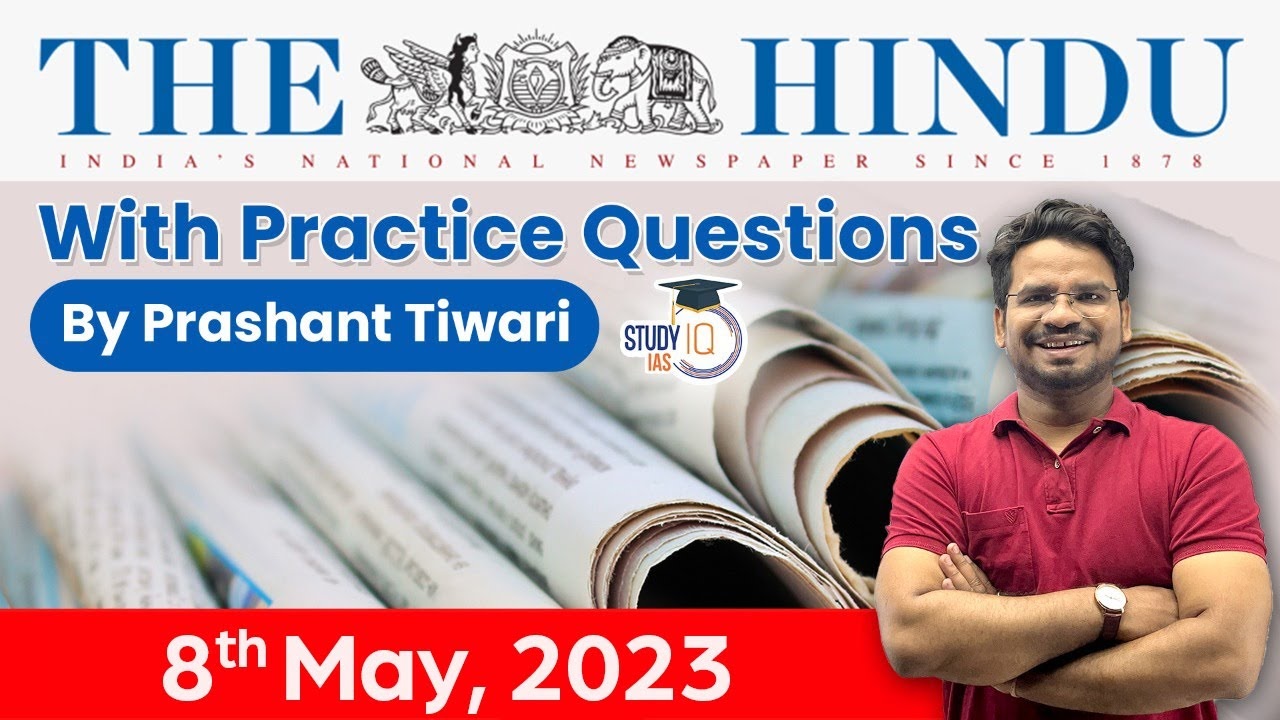The Hindu Newspaper Analysis for UPSC

The Hindu Newspaper Analysis 6 May 2023
- in outbreaks and epidemics, policy interventions and preventive advice need to factor in the local context. The context determines the epidemiological pattern, spread of disease and proposed interventions thereof.
- an extremely worrying and unsettling trend has been the ‘ dogmatic stand’ that many ‘self-proclaimed experts’ and influencers have adopted, and who are continuing to selectively and conveniently use emerging evidence and published literature to support their stand.
- if there were the ‘COVID deniers’ at the beginning of the pandemic posing a challenge, it is now the ‘COVID-foreverers’, i.e., a group of disparate individuals and social media groups that keep insisting on the enforcement of restrictions such as universal masking at ‘the drop of the hat’, often on frivolous grounds.

- The paper first delineates the core principles which inform Beijing’s policy choices — the ‘Three Respects’ and ‘Three Nevers’, i.e., China respects the independence, sovereignty and territorial integrity of Afghanistan and the ‘independent choice’, religious sentiments and national customs of the Afghan people.
- These principles are put in opposition to the policies followed by the West which, according to Beijing, are informed more by geopolitics and their vested interests.
- Urging the international community to view the Afghan issue in a ‘comprehensive, balanced and objective manner’, China advocates using alternative regional groupings which do not include the U.S. and its allies, such as the Shanghai Cooperation Organisation (SCO), the Moscow Format Dialogue, the Foreign Ministers’ group which just met, and the China-Afghanistan-Pakistan Trilateral Foreign Ministers’ Dialogue, for discussing the Afghan issue.
- Since the beginning of 2023, China has taken incremental steps to entrench its image as a major country playing a crucial role in ensuring global governance and providing a ‘moderate and pluralistic environment’ for dialogue.

- As China, India, and Russia dabble in trade using partner currencies for payment instead of the U.S. dollar, various media are rife with speculation about the demise of the dollar as world reserve currency.
- The status of the U.S. dollar as a preferred currency for international trade and as a reserve currency has not been a result of any purposeful policy or an international agreement. The rise of the dollar as the world currency closely aligns with the rise of the U.S. as one of the world’s strongest economies with a deep financial system and a stable government. This is not to say there were no competitors
- According to reports from the International Monetary Fund, the dollar’s share of foreign exchange reserves has fallen over time from 80% in the 1970s to about 60% in 2022. The euro has made up for about 20% of the remaining 40% room created by this fall.

- India’s goods trade numbers for February and March have been revised by over $10 billion from initial estimates, and the overall export-import figures for last year have been scaled down by around $3 billion dollars each, with experts flagging petroleum shipments as the main driver for the extraordinarily high revisions of recent export data.
- While exports were earlier reckoned to have grown 6% in 2022-23 to hit $447.46 billion, that number has now been pared to $444.4 billion, reflecting a 5.3% rise from 2021-22. The import bill for last year has also been scaled down from $714.24 billion to $711.85 billion, indicating a growth of 16.1%.
- The trade deficit for the year has risen 40.8% to $267.45 bn, slightly higher than the 40% estimated earlier.

- The Indian Space Research Organisation (ISRO) has announced a new introductory-level online training programme called space science and technology awareness training (START).
- START is aimed at postgraduate and final-year undergraduate students of physical sciences and technology.
- “The START programme is part of the ISRO’s efforts to enable Indian students to become professionals in space science and technology, as the organisation’s space science exploration programme continues to expand into new domains,” the ISRO said.

- The Arab League on Sunday welcomed back Syria’s government, ending a more than decade-long suspension and securing President Bashar al-Assad’s return to the Arab fold after years of isolation.
- In November 2011, the 22-member body suspended Damascus over its crackdown on peaceful protests which began earlier that year and which spiralled into a civil conflict that has killed more than 5,00,000 people, displaced millions and battered the country’s infrastructure and industry.
- It is a regional organization of Arab countries in and around North Africa, the Horn of Africa and Arabia.
- Formed in Cairo on 22 March 1945 with six members: Kingdom of Egypt, Kingdom of Iraq, Jordan, Lebanon, Saudi Arabia, and Syria. Currently, the League has 22 members, but Syria’s participation has been suspended since November 2011, as a consequence of government repression during the Syrian Civil War.
- Main goal is to “draw closer the relations between member States and co-ordinate collaboration between them, to safeguard their independence and sovereignty, and to consider in a general way the affairs and interests of the Arab countries “.



 The Hindu Newspaper Analysis 6 October 2...
The Hindu Newspaper Analysis 6 October 2...
 The Hindu Newspaper Analysis 5 October 2...
The Hindu Newspaper Analysis 5 October 2...
 The Hindu Newspaper Analysis 4 October 2...
The Hindu Newspaper Analysis 4 October 2...





















